- What’s the Difference Between a Job Description, Job Posting, and Job Ad - June 5, 2025
- Top 20+ Diversity Equity Inclusion Titles (with Descriptions) 2024 - October 18, 2024
- A List of Common Offensive (Exclusionary) Words Used in Job Descriptions (2024) - October 18, 2024
Want to recruit veterans or enlisted members of the military? I’m guessing yes. There are 1 million+ people in the U.S. Armed Forces and 250,000 per year transition out of the U.S. military.
If you want to recruit veterans better, first you have to speak their language…their job lingo in particular.
Veterans and enlisted members speak of jobs in terms of “military job codes”. The U.S. Military uses the following sets of military job codes:
- The U.S. Army and Marines use Military Occupational Specialty Codes (or “MOS Codes” for short). Their codes are here: Army MOS Codes List
- The Air Force uses “AFSC Codes” (short for Air Force Specialty Codes). See the Air Force AFSC List
- The Navy uses NEC Codes (Navy Enlisted Classification Codes). Their codes are here: Navy NEC Codes List
Military job codes are usually around 2 to 6 characters each. Some examples:
- 26B = Information Systems Engineer
- 42B = Human Resources Officer
- 66B = Nurse
- 5J = a Paralegal
So, for instance, a veteran looking for an HR job might search the Web for “42B jobs” (not HR jobs).
To recruit veteran and enlisted member candidates you can’t rely on just the job posting title and job description. You need to weave in that military job code somewhere.
The Good News: Top Boards Help Recruit Veterans for You
The good news is that leading job boards already support military job codes to help recruit veterans for you. The following job boards support military job codes in their job searches:
- Indeed
- Glassdoor
- Google.com
- CareerBuilder
For example, if you search “42B” on one of those job boards, you’ll likely get a list of senior HR job postings. Many military-centric job boards support such searches too.
The Bad News: You Likely Don’t Support Veteran Job Search
The bad news is that your own company career site likely doesn’t support military job codes. You’re probably using your ATS job search on your career site and I don’t know of any ATS that supports military job codes.
So, when a veteran searches your career site for 42B or any military job code they will likely get zero results (or some irrelevant results) on your career site.
That’s not a good way to recruit veteran and enlisted members.
But there’s relief in sight.
Solution: Use New AI Veteran Job Search For Your Career Site
You can now leverage the awesome AI Job Search technology coming out of Google’s Cloud Talent Solutions. Google’s AI Job Search tech includes support of military job codes.
Here are some examples:
On J&J’s career site, if you search 66B (code for “Community Health Nurse”), you get these 3 relevant results (out of 1,667 jobs!):
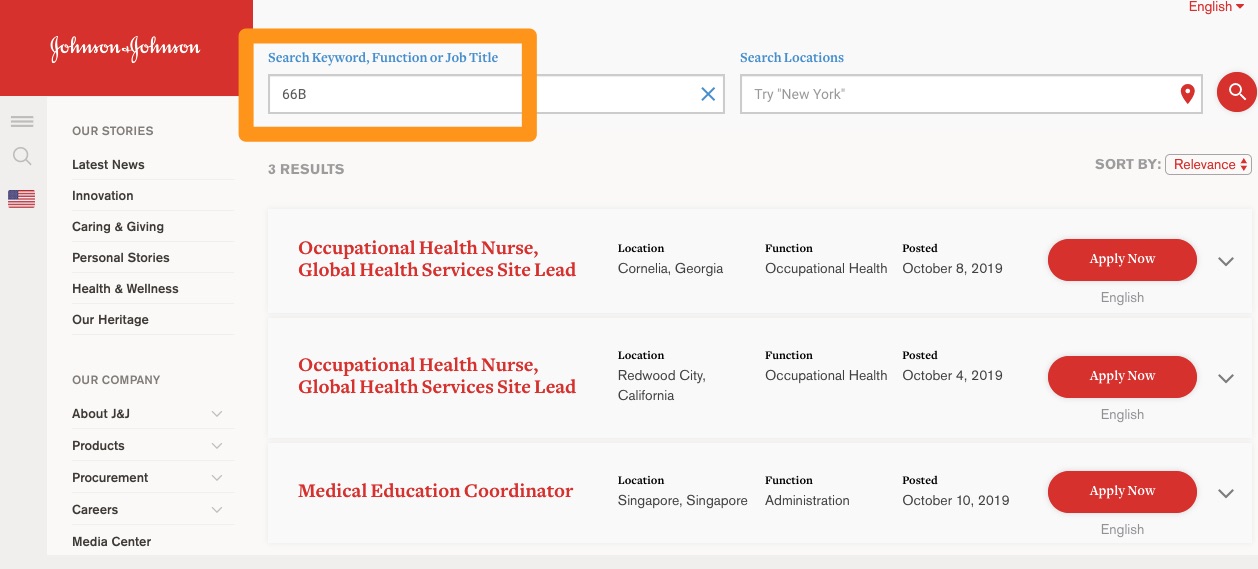
On Westrock’s career site (see below) if you search 42B (code for “Human Resources”), you get HR-related jobs:
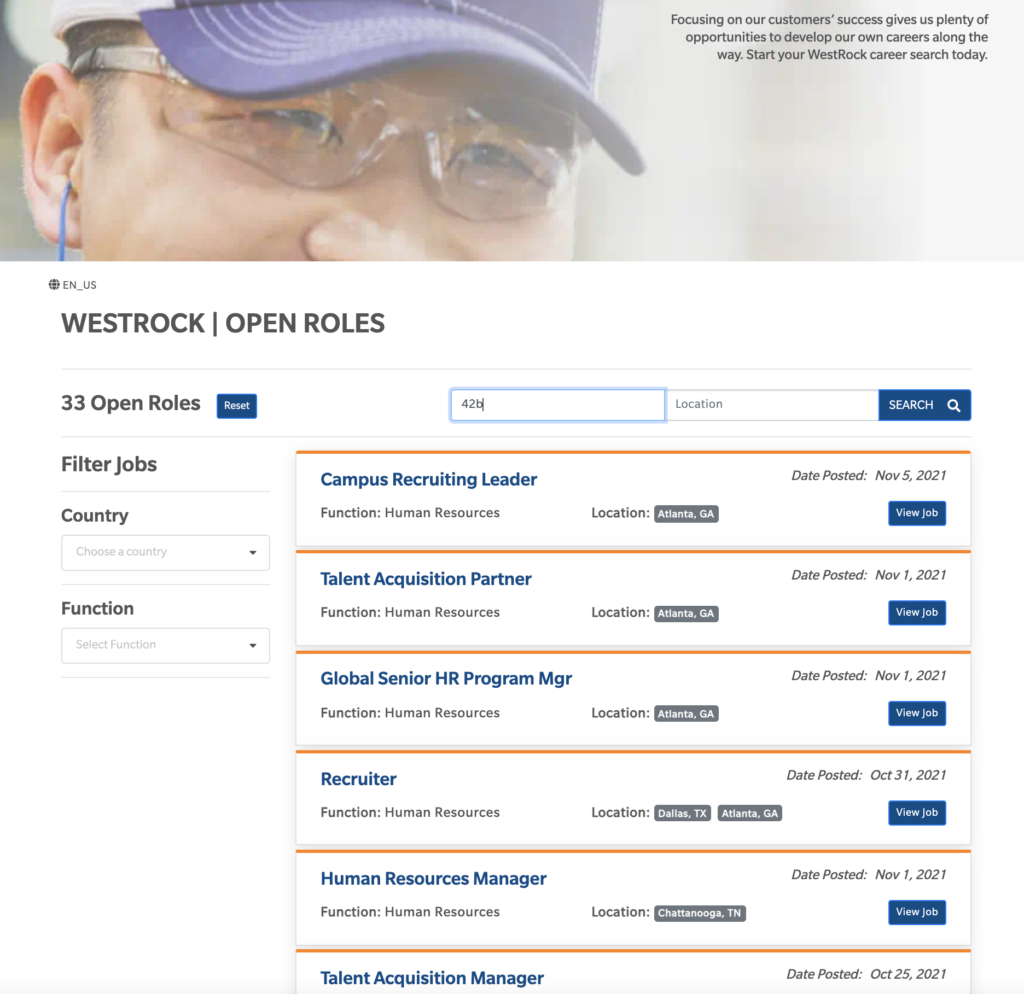
On Synopsys’ career site, if you search 26B (code for “Information Systems Engineer”), you get 5 relevant results like the ones below.
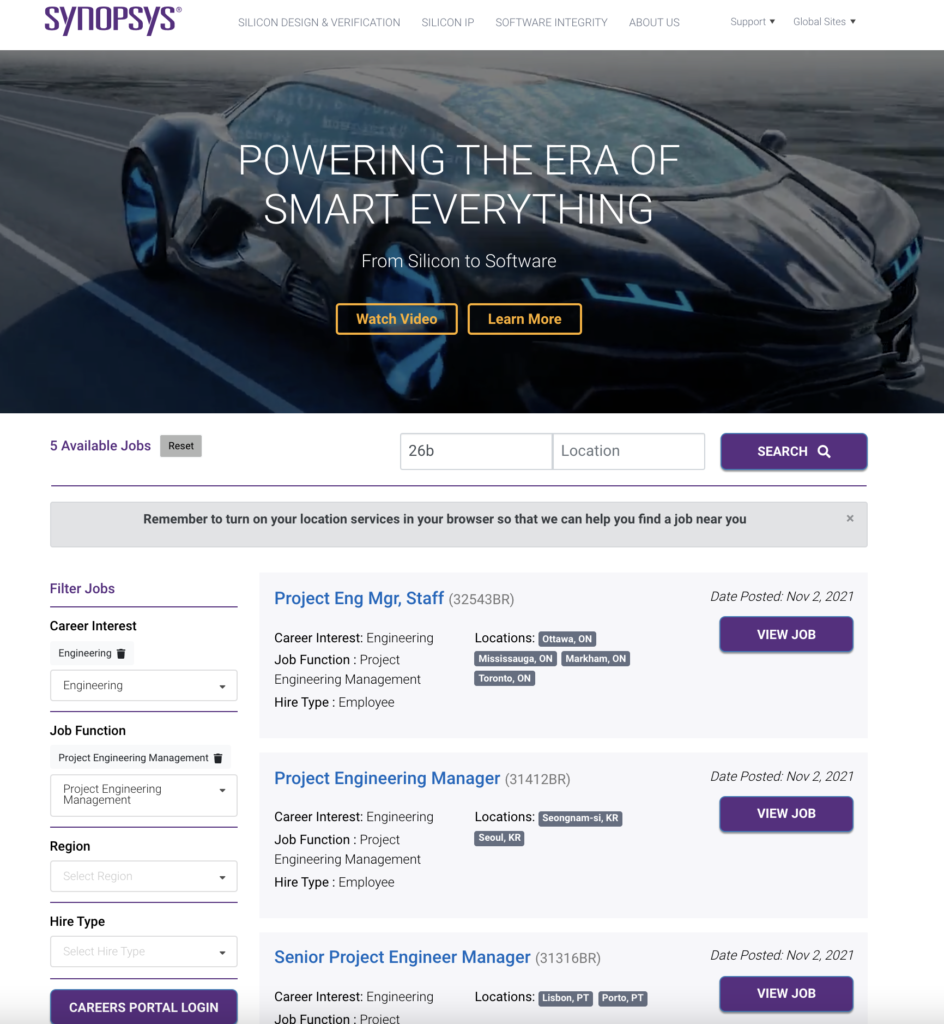
“We were really excited when we learned that Ongig’s AI job search extends to and supports Veterans. Synopsys is focused and committed to recruiting Veterans and this functionality supports our commitment and is a step in the right direction for us and our job seekers.”
— Caitlin Perez, Talent Programs Manager at Synopsys
On Anixter and Peak6’s career sites (below), you’ll see that a veteran searching 25a (code for “Signal Officer”/Operations) generates the closest jobs both co’s have for someone with that background:
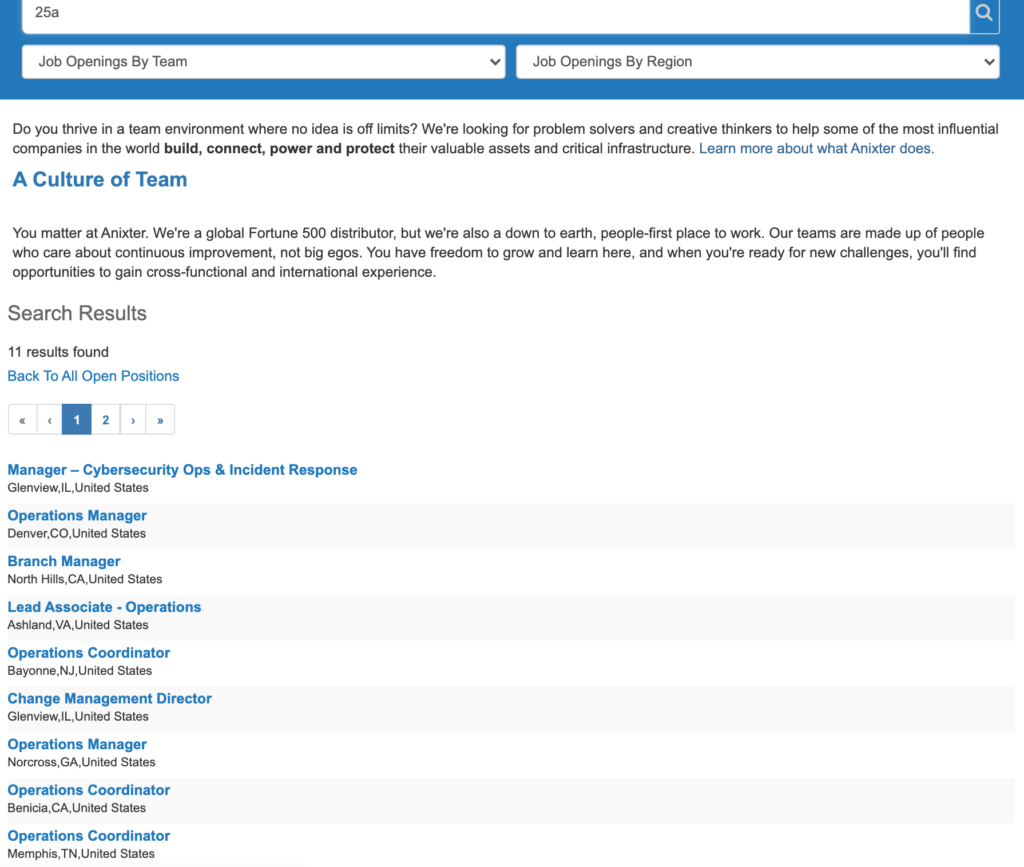
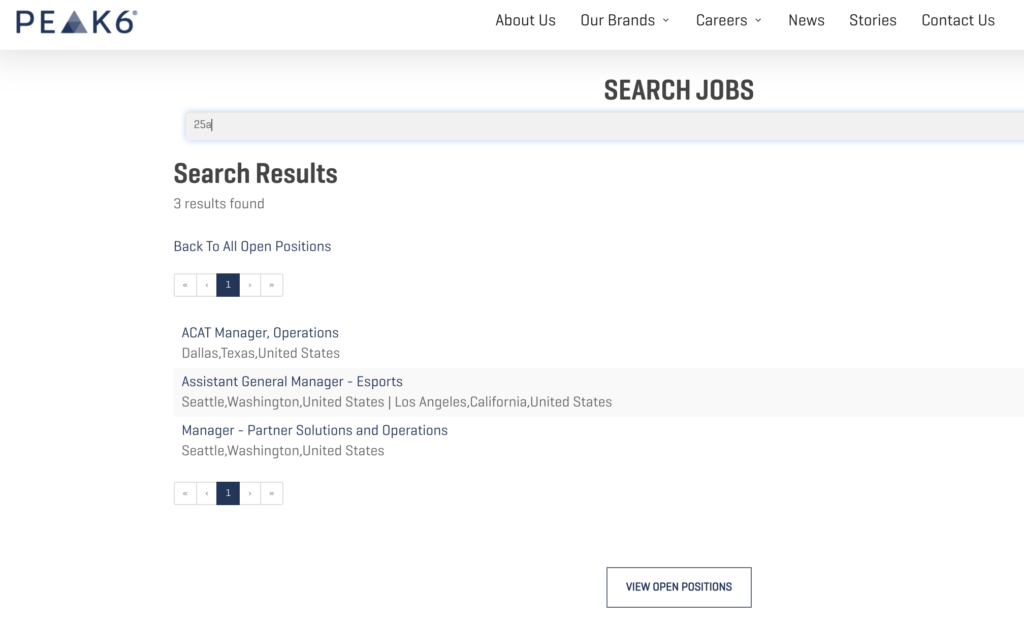
8 Options to Get Veteran Job Search on Your Career Site
If you want to recruit veterans better using the types of job search above, there are a couple of choices.
1. Hire a Custom Developer — You could hire a custom developer and work with Google on building the veteran job search into your career site. You’d pay Google a subscription fee per query. The developer would need to work with your ATS’s APIs (if your ATS has one). You’d need the developer to monitor the new job search on an ongoing basis.
Additionally, you can also ask your developer to:
- Add filters to your job search function that allow veterans to find roles that match their military skills and experience.
- Integrate Military Occupational Specialty (MOS) code translation tools to help veterans find civilian roles that align with their military experience.
2. Subscribe to a Career Site Builder Software Solution — If you’re in the market for a new career site, Google has partnered with 11 companies that have access to Google’s tech. Some of those partners sell career site builder software solutions that include the veteran job search. The 2 Google partners I see offering the veteran job search are Jibe (now part of iCIMS), and Ongig (yes, that’s us — shameless plug!). Career site builder software solutions tend to range in price from $10,000 to $150,000 per year.
3. A.I. Job Search Embed — If you want veteran job search without revamping your entire career site, there’s one more option. You can invest in Ongig’s AI Job Search Embed. Ongig gives you 3 lines of code to add to your career site that lets you embed just the Google AI Job Search box. The job search then searches any jobs coming out of your ATS and when the candidate clicks on the awesome results, they are sent to your usual job posting pages.
4. Write veteran-friendly job descriptions – tailor your job adverts to include veterans’ skills and experiences. It can help improve candidate experience because it makes it easier for ex-military personnel to identify and apply for positions that fit their expertise. It also positions you as a veteran-friendly employer, attracting a larger pool of talented veteran candidates.
Tips:
- Understand common military skills and accurately translate them into civilian job requirements.
- State your company’s commitment to hiring veterans. Include veteran-specific employee benefits like mentorship programs, veteran resource groups, or training programs for veterans.
- Use inclusive language. Ongig’s Text Analyzer alerts recruiters to civilian-specific jargon or assumptions that may not be familiar to veterans and replaces them with simpler words and phrases.
- Encourage veterans to apply by explicitly stating that their military experience is valued. Include statements from leadership about the company’s commitment to veteran hiring and support.
- Include testimonials or success stories from veterans currently employed at your company and how they have successfully transitioned to civilian roles within your organization. Mention any recognition or awards your company has received for veteran hiring and support.
- Collect feedback from applicants and hiring managers on the effectiveness of the job descriptions and update them based on their input to better meet the needs of veteran job seekers.
Example:
Job Title: Project Manager
Job Overview:
As a Project Manager, you will lead cross-functional teams to deliver projects on time and within budget. Your leadership and organizational skills, honed in the military, will be crucial in managing complex projects and driving success.
Key Responsibilities:
- Lead project planning, execution, and delivery
- Coordinate with stakeholders to define project scope and objectives
- Develop and manage project schedules, budgets, and resources
- Identify and mitigate project risks
- Ensure project deliverables meet quality standards
Required Skills and Experience:
- Proven leadership experience, ideally in a military or similar environment
- Strong organizational and problem-solving skills
- Excellent communication and teamwork abilities
- Ability to manage multiple projects simultaneously
- Experience with project management tools and methodologies
Preferred Qualifications:
- Project Management Professional (PMP) certification or equivalent
- Experience in a fast-paced, dynamic environment
Why Join Us:
- We value the unique skills and perspectives veterans bring to our team
- Comprehensive training and development programs tailored to veterans
- Mentorship and support from veteran colleagues
- Competitive salary and benefits, including health insurance, retirement plans, and more
Application Process:
- Apply online with your resume and cover letter
- Veterans are encouraged to highlight their military experience and skills
- For assistance with your application, contact our veteran support team at [email]
EEO Statement:
We are committed to creating a diverse and inclusive workplace that values veterans’ contributions. We proudly support veterans transitioning to civilian careers and offer a range of programs and benefits designed to help veterans thrive in our organization.
5. Use veteran job boards – integrate job listings from popular job boards into your career site to reach many veteran job seekers and improve your site’s reputation for employing veteran workers.
Tips:
- Ask your developer to integrate veteran-focused job boards’s APIs (Hire Heroes USA, RecruitMilitary, and Military.com) into your career site.
- Ensure your jobs imported from these job boards are correctly filtered and categorized within your site.
- Highlight your veteran job listings in a dedicated section of your career site.
6. Create veteran-specific content and resources – build a library of content and resources to support military job seekers. This includes written articles, videos, and guides that provide actionable advice and address common challenges of veterans looking for jobs. Doing this will position your site as a trusted resource for veteran employment.
Tips:
- Collaborate with career coaches, veteran workers, HR professionals, and marketers to create a content strategy specific to military veterans. Develop content on topics that would help them, such as writing resumes, preparing for interviews, and transitioning to civilian careers.
- Produce different types of content, such as blogs, video tutorials, and downloadable guides. Put them into a dedicated section of your career site so veteran applicants can access time anytime.
- Provide links to external resources, such as veteran-focused support organizations, nonprofits, and government programs that assist veterans in their employment.
- Offer access to veteran career coaches who can assist in personalized job search and career advice.
- Promote your content in email newsletters, social media, and partnerships with veteran organizations.
7. Organize virtual career fairs and job events. Hosting job events allows veteran applicants to connect with employers looking to hire veterans in real-time, facilitating better engagement and networking opportunities.
Tips:
- Schedule a virtual job fair focused on veteran hiring at least once or twice a year. Invite veteran-friendly employers to join and advertise their job openings.
- Choose a reliable virtual event platform for video conferencing, chatting, and other interactive features.
- Promote your virtual job event on your career site, social media, and veteran organizations. Set up a registration process for both employers and job seekers.
- After your virtual event, gather participant feedback and give follow-up resources and support.
8. Build veteran hiring programs designed to help ex-military personnel transition to civilian employment. Launch apprenticeships and internships that offer hands-on training and skills development to veterans. You can also create fellowships that aim to enhance their special skills and leadership abilities. Such programs demonstrate a commitment to hiring veterans, bringing diverse perspectives, and fostering inclusivity.
Tips:
- Set hiring goals to provide a clear and measurable target for veteran employment. They guide the development of your mentorships or apprenticeships. They also help allocate resources effectively, giving you sufficient support and funding for your programs.
- Promote your programs on your career site, detailing the benefits and application process. You can partner with support organizations to spread the word about your mentorships. You can also host informational events and webinars to engage with the veteran community and explain your hiring process.
- Review the implementation and outcome of your veteran programs. Did it result in more veteran employees? Were there more veterans promoted to higher positions?
- Update stakeholders on the outcome of your veteran programs. Report progress toward veteran hiring goals to maintain transparency and accountability.
Why I wrote this?
Ongig is on a mission to transform job descriptions. One way to do this is to allow job postings to be easily searchable by any group (including veterans). That’s why we partnered with Google on AI Job Search. Request a demo if you’d like to learn more.
